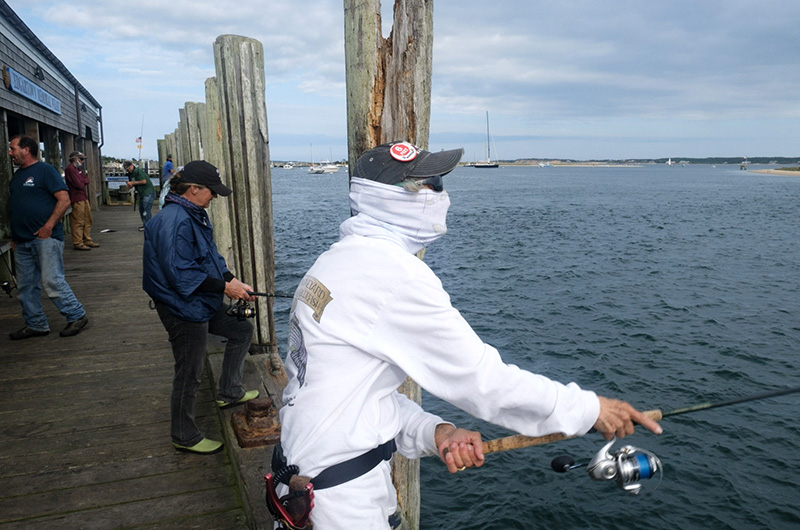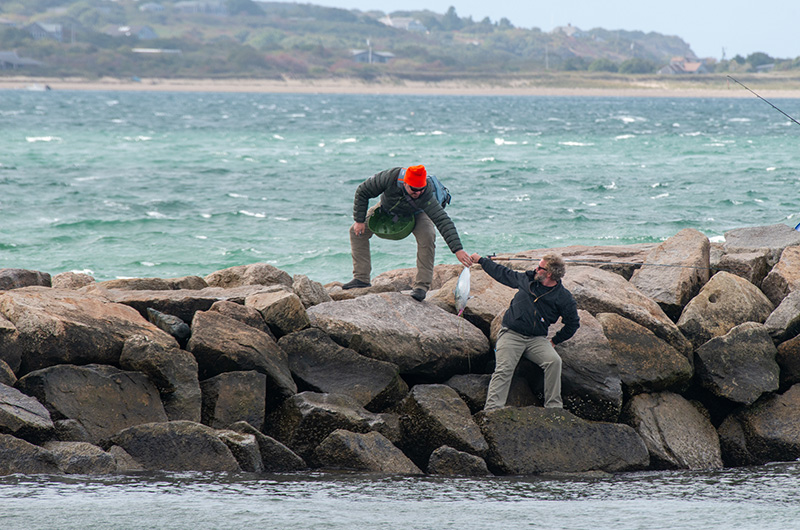The weigh station has been buzzing at derby headquarters, as cool autumn days arrive and the fishing heats up.
“The fishing has been phenomenal,” derby chairman Joe El-Deiry said, reporting that more than 100 fish crossed the scales last Saturday.
“There were a lot of fish coming through. The lines were out the door for most of the night. It was pretty much nonstop weighing fish from 8 to 10 p.m.,” he said.
And with striped bass out of the contest, a conservation measure to protect the species, chasing albies has emerged as a big part of the derby this year.
False albacore can be found in Atlantic waters ranging from New England to Brazil. In recent years it has become a sought-after derby fish, with anglers enjoying the challenge of landing one.
But albies haven’t always been in Vineyard waters. Cooper Gilkes 3rd, one of the senior statesmen of fishing on the Vineyard, said when he was a kid growing up on the Island they were nowhere to be found.
That changed in the 1980s when water temperatures around the Island crept up a few degrees and schools of albies showed up, feasting on swarms of baitfish. Today they can be found just about anywhere baitfish congregate — in harbor inlets, around jetties and on sandbars.
Janet Messineo, another derby veteran, also remembers the days when there were no albies to be found in Vineyard waters. She caught her first one in 1985 off the Oak Bluffs Steamship Authority wharf.
“You find the bait, you’ll find the fish,” Ms. Messineo quipped this week.
Edgartown angler David Nash agreed. “If you like to fish, they’re a lot of fun. They’re fast, they’re powerful, you don’t know what direction they’re going to go but eventually, they tire and you can bring them in,” he said.
For non-keepers, quick release is also important. “They die about as quickly out of the water as you or I would die in the water,” Mr. Nash said. “Most of the time they put up a very good fight and they’re exhausted when they come in.” He added:
“The fish gives us a lot of enjoyment. We can return the favor by releasing them quickly and alive.”
False albacore became a derby fish in 1985. Because it is generally viewed as inedible, the derby committee has taken steps over the years to reduce landings. In 1995, daily prizes for albies stopped. In 1998, a minimum length of 25 inches was adopted. In 2005, the committee adopted a bag limit of three fish per angler per derby.
“It almost doesn’t matter which end of the Island you’re on, north shore, or up in Gay Head, or in the Edgartown-Oak Bluffs area, there are still a lot of false albacore,” said derby stalwart Chris Scott. “The real excitement and fun is when you see the birds working frantically over a breaking school. It gives derby fever a whole new meaning.”
Evandro Medici, an avid derby fisherman, described the chase for albies as just plain fun. “The thrill of being out there and out of nowhere seeing bait scatter, or even the slightest movement of water and knowing they’re there. Then you have that thought in your mind that any second that drag is going to be running,” he said. “Everything about albie fishing is fun. You just have to be patient and also be willing to move around and try out different tackle, because they’re quick and really finicky fish.”
Halfway through this year’s derby, as of Wednesday night, a total of 239 false albacore had been weighed in at a combined weight of 1,962 pounds. In the 2014 derby, 520 albies were weighed in, the most in a single year since the new rules were adopted. Last year, 178 albies crossed the scales.
As of Wednesday night, Stephen W. Luce led the boat-caught false albacore category with an 11.4-pound fish. Matthew Winter led the shore-caught false albacore category with a 10.4-pound fish.
In other categories, Dill Kleeman, a junior angler, led the boat-caught bluefish category with a 15.55-pound blue. Peter C. Shepardson led the shore-caught bluefish category with a 12.98-pound blue. In the bonito category, Greg G. Clark’s 12.34-pound fish remained in the top spot in the boat-caught category. John Thurgood’s 10.48-pound bonito led in the shore-caught category.










Comments
Comment policy »